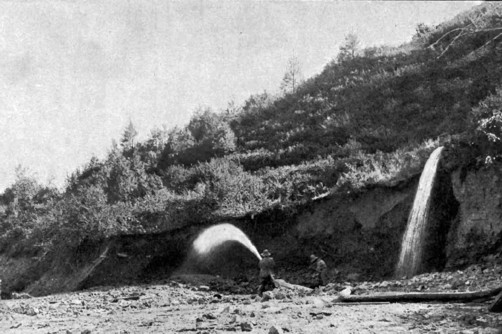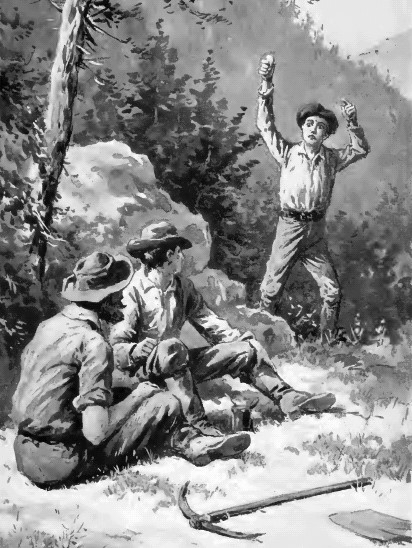For the mines of Eastern Oregon we have no such careful reports as those of Lindgren for Idaho. The eastern Oregon mines, indeed, seem scarcely to have received the attention that their importance in building up that part of the state warrants. While there were discoveries on Malheur and Burnt Rivers, the most important centers were Canyon City on Canyon Creek (a branch of John Day's River), and at Auburn on Powder River, about ten miles southwest of the present Baker City. The placers on the John Day were discovered in November, 1861, by a party of thirty-two men from The Dalles. Fourteen of these started back to The Dalles, but all except two were killed by the Indians. A very considerable immigration followed the next year, particularly from Washoe, and settlers soon began to take up farms in the beautiful and fertile valley of the John Day. Miners went to work vigorously making dams and rigging pumps, and Portland capitalists became interested. In 1865 twenty-two thousand dollars per week was produced during the mining season, and in 1866 Carmany thought that the John Day mines had produced $1,500,000.
The Powder River mines, also, were discovered in the fall of 1861. In June, 1862, Auburn was laid out and for a few months grew rapidly. It soon had forty stores and saloons, five hundred houses, and by winter a population estimated at 3000. In the dozen gulches of the district men were in June making from five to thirty dollars per day. A valuable quartz lead, the Rocky Fellow, was soon discovered. Two executions occurred, one in legal form, another that of a Spanish gambler by the mob. Settlers began taking up lands along Powder River and many immigrants or "Pilgrims" came in from the East, so that at one time there were 150 women in camp. But in 1863 the immigrants began to turn to the beautiful Grande Ronde valley and helped to build up La Grande, and the miners, finding that the water supply was inadequate, flocked away to Boise Basin and to other camps, and decline rapidly set in.
Auburn was a ' mother of mining camps ' whence prospecting parties explored in all directions. An interesting political development occurred, however, in 1862, when the people in the vicinity of Auburn, not being content with being an election precinct of "Wasco County, organized a new county and named it Baker (after the famous senator of that name), elected a full set of county officers, and chose J. M. Kirkpatrick to represent them in the next legislature. But the legislature temporarily refused its sanction. It is significant of the growth of Eastern Oregon that in the presidential vote of 1864 the counties east of the Cascades polled 4455 votes out of a total for the State of 18,350. The political proclivities of the majority of the residents are indicated from the fact that while the state went for Lincoln by 1431 votes, McClellan carried the eastern counties by 287 votes.
The miners liked to return to Portland to winter. The portion of the surplus from the placer mines, which was expended in Portland, seems to have been quite well distributed in all kinds of business, but it was noticed that, as the placer mines passed their zenith, "the quartz mines, controlled by capital send their product abroad through narrow channels, so that little reaches the general public." Still, the city had received such a marked accession of population, business, and wealth as to insure permanent and steady growth.
Mining also had a strong revival in the southern and eastern counties, while new discoveries and rediscoveries were made in the Cascade range in Marion and Clackamas counties. No gold rush mining furor like that is likely ever to take place again in this state, if anywhere in the northwest. Placers such as drew thousands to Rogue river in 1851, and to John Day river in 1862, will probably never again be discovered. The hydraulic gravel mines of Jackson and Josephine counties have proved valuable properties, and a few gold ore quartz mines on the eastern border of the state have returned good profits. The reduction works at East Portland were erected chiefly to reduce the rich ores of the Coeur d' Alene silver district in the state of Idaho.
Much Oregon capital had become interested in Coeur d' Alene, and also in the recently discovered mines of Salmon river in eastern Washington, which were found upon the Chief Moses' reservation, which is in the Okanagan country of the upper Columbia, once hastily prospected by miners in the Colville mining excitement, but only known to contain quartz mines since 1887. The total gold product of Oregon in 1887 was over half a million, and of silver about $25,000.
The Coeur d' Alene furnishes galena-silver ore. The Sierra Nevada mine, yielding ore consisting of galena and carbonates, is said to average 94. 79 in lead and silver. A block of galena weighing 760 pounds assayed 69 per cent lead, and $1.10 in silver per ton. Some of the specimens are of rare beauty, the native silver being in the form of wire intermingled with crystals of carbonate, arranged upon a back ground of a dark metallic oxide, and appearing like jewels in a velvet lined case. Some of the prominent mines are the Bunker Hill, Sullivan, the Tyler, the Ore-or-no-go, and the Tiger. The mineral resources of the more important Oregon counties are: Baker: gold in quartz and placers, silver in lodes, copper, coal, nickel ore, cinnabar, building stone, limestone and marble. Benton: coal, building stone, gold in beach sand, iron. Clackamas: iron ore and ochres, gold in quartz, copper ore, galena, coal, building stone. Clatsop: coal, potter's clay, iron ore, jet. Columbia: iron ore, coal, manganese ore, salt springs. Coos: coal, gold in beach sand, streams, and quartz, native platinum, iridosmine, brick clay, chromite iron, magnetic sands. Crook: gold in placers. Curry: iron ore, gold in river beds and beach sands, platinum, iridosmine, chrome iron, borate of lime, building stone, silver and gold (doubtful). Douglas: gold in lodes and placers, nickel ore, quicksilver, copper, native and in ore, coal, salt springs, chromium ore, platinum ore, iridosmine, natural cement, building stone. Gilliam: coal. Grant: gold in lodes and placers, silver ore in lodes, coal, iron. Jackson: native gold.
Return
to The Oregon History Page:
Oregon Gold Rush History



